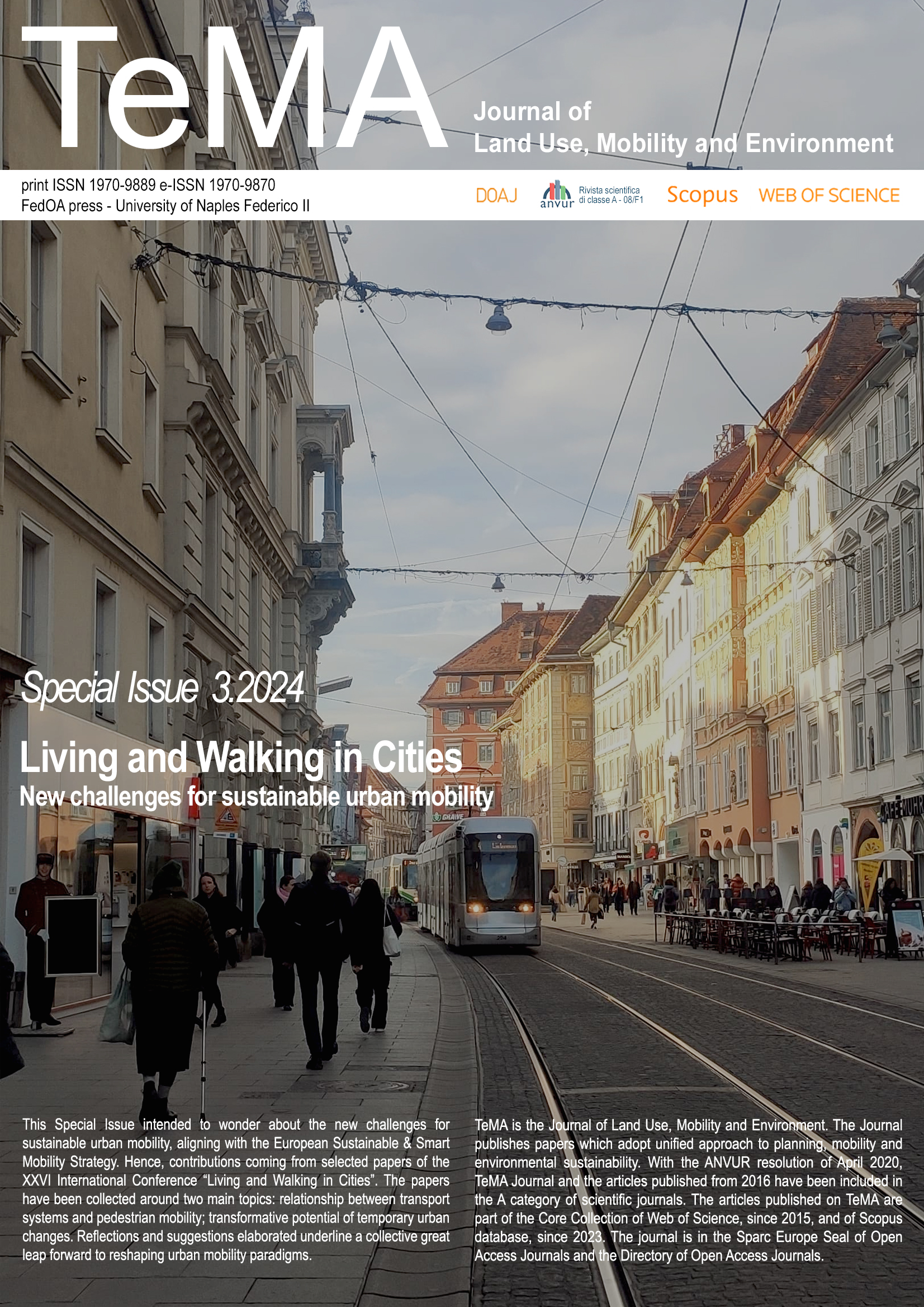The exploration of tactical urbanism as a strategy for adapting to climate change. The "SpaziAttivi" program in the city of Brescia
Abstract
Lately, conventional urban planning strategies have encountered a new and often opposing force known as Tactical Urbanism, which has gained widespread prominence. This movement represents an approach to addressing issues at the neighborhood level, intervening in public spaces through citizen involvement and implementing temporary, cost-effective solutions. The Municipality of Brescia is actively exploring this innovative approach through the 'SpaziAttivi' project, a component of the Climate Transition Strategy approved in 2021. This paper aims to elucidate why tactical urbanism has been chosen as the preferred method to enhance understanding, awareness, and the adoption of a collaborative approach to addressing climate change adaptation and mitigation issues. Specifically, the paper seeks to delineate the methodological process employed in selecting areas for tactical urbanism experiments, considering other successful participatory processes in Tactical Urbanism. The selection process ultimately leading to the decision to intervene in two areas, a significant reduction from the initial 56 proposals put forth by the citizens.
Downloads
References
Bishop, P. & Williams, L. (2012). The temporary city. London: Routledge
Blaga, O.-E. (2013). Pedestrian Zones As Important Urban Strategies in Redeveloping the Community - Case Study: Alba Iulia Borough Park. Transylvanian Review of Administrative Sciences, 38E, 5-22.
Boglietti, S. & Tiboni, M. (2022). Public spaces critical issues analysis for soft mobility. TeMA - Journal of Land Use, Mobility and Environment, 131-145. https://doi.org/10.6093/1970-9870/8643
Carra, M., Rossetti, S., Tiboni, M. & Vetturi, D. (2022). Urban regeneration effects on walkability scenarios. TeMA - Journal of Land Use, Mobility and Environment, 101-114. https://doi.org/10.6093/1970-9870/8644
Comune di Bologna e FIU (Fondazione Innovazione Urbana) (n.d.). Piazze Scolastiche a Bologna. Retrieved from: https://www.comune.bologna.it/mandato-2021-2026/azioni/cinque-nuove-piazze-scolastiche/
Comune di Brescia con il contributo di Fondazione Cariplo (n.d.). Strategia di Transizione Climatica - Un Filo Naturale - Una comunità che partecipa per trasformare la sfida del cambiamento climatico in opportunità. Retrieved from: https://www.comune.brescia.it/sites/default/files/imported/servizi/urbancenter/unfilonaturale/Documents/210720_UC_AT_188-RELAZIONE_STC_BS_rev2.pdf
Comune di Milano, AMAT - Agenzia Mobilità Ambiente Territorio in collaborazione con Bloomberg Associates e Global Designing Cities Initiative (n.d.). Piazze Aperte Un programma per lo spazio pubblico di Milano. Retrieved from: https://www.comune.milano.it/documents/20126/33917286/Piazze+Aperte+Report_ita.pdf/61b5a205-c927-959e-5978-e678d6c02642?t=1657879170942
D’Amico, A. (2023). Urban spaces and pedestrian mobility: the role of urban design for enhancing walkability. TeMA - Journal of Land Use, Mobility and Environment, 16 (3), 639-644. http://dx.doi.org/10.6093/1970-9870/10327
Fasolino, I., Grimaldi, M. & Coppola, F. (2020). The paradigms of urban planning to emergency-proof. TeMA - Journal of Land Use, Mobility and Environment, 165-178. http://dx.doi.org/10.6092/1970-9870/6847
Finn, D. (2014). DIY urbanism: implications for cities. Journal of Urbanism: International Research on Placemaking and Urban Sustainability, 7 (4), 381–398. https://doi.org/10.1080/17549175.2014.891149
Healey, P. (2007). Urban Complexity and Spatial Strategies: Towards a Relational Planning for Our Times. London: Routledge
Henneberry, J. E. (2017). Transience and permanence in urban development. Oxford: Wiley Blackwell
La Greca, P. & Martinico, F. (2016). Energy and spatial planning: a smart integrated approach. In Smart energy in the smart city. Urban planning for a sustainable future, 43-59, Switzerland: Springer
Lydon, M., & Garcia, A. (2015). Tactical Urbanism: Short-term Action for Long-term Change. Washington, Covelo, London: Island Press
Shmelev, S.E. (2019). Sustainable cities reimagined: multidimensional assessment and smart solutions. New York: Routledge
Tonkiss, F. (2013). Austerity urbanism and the makeshift city. City, 17 (3), 312–324. https://doi.org/10.1080/ 13604813.2013.795332
Tardiveau, A. & Mallo, D. (2014). Unpacking and Challenging Habitus: An Approach to Temporary Urbanism as a Socially Engaged Practice. Journal of Urban Design, 19 (4), 456-472. https://doi.org/10.1080/13574809.2014.923743
Wohl, S. (2018). Tactical urbanism as a means of testing relational processes in space: A complex systems perspective. Planning Theory, 17 (4), 472–493. https://doi.org/10.1177/1473095217722809
Yassin, H. H. (2019). Livable city: An approach to pedestrianization through tactical urbanism. Alexandria Engineering Journal, 58(1), 251–259. https://doi.org/10.1016/j.aej.2019.02.005
Zecca, C., Gaglione, F., Laing, R. & Gargiulo, C. (2020). Pedestrian routes and accessibility to urban services: an urban rhythmic analysis on people's behaviour before and during the COVID-19. TeMA - Journal of Land Use, Mobility and Environment, 13 (2), 241-256. https://doi.org/10.6092/1970-9870/7051
Copyright (c) 2024 TeMA - Journal of Land Use, Mobility and Environment

This work is licensed under a Creative Commons Attribution 4.0 International License.
Authors who publish in this journal agree to the following:
1. Authors retain the rights to their work and give in to the journal the right of first publication of the work simultaneously licensed under a Creative Commons License - Attribution that allows others to share the work indicating the authorship and the initial publication in this journal.
2. Authors can adhere to other agreements of non-exclusive license for the distribution of the published version of the work (ex. To deposit it in an institutional repository or to publish it in a monography), provided to indicate that the document was first published in this journal.
3. Authors can distribute their work online (ex. In institutional repositories or in their website) prior to and during the submission process, as it can lead to productive exchanges and it can increase the quotations of the published work (See The Effect of Open Access)

